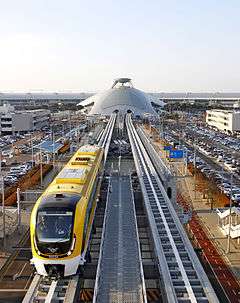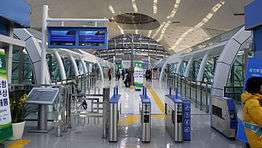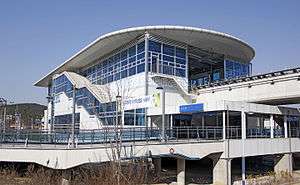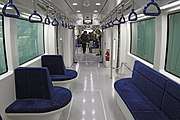Incheon Airport Maglev
| Incheon Airport Maglev | |||
|---|---|---|---|
 | |||
| Overview | |||
| Native name |
인천공항 자기부상철도 (仁川空港 磁氣浮上鐵道) Incheon Gonghang Jagi Busang Cheoldo | ||
| Type | Maglev | ||
| Status | In operation (free to the public) | ||
| Termini |
Incheon International Airport Terminal 1 Station Yongyu Station | ||
| Stations | 6 | ||
| Operation | |||
| Opened | February 3, 2016[1] | ||
| Operator(s) | Incheon Transit Corporation, Incheon International Airport Corporation | ||
| Technical | |||
| Line length | 6.1 km (3.8 mi) | ||
| Number of tracks | 2 | ||
| Track gauge | 1,850 mm (6 ft 27⁄32 in) | ||
| Electrification | DC 1500V | ||
| Operating speed | 110 km/h (68 mph) | ||
| Highest elevation | 24.5 m (80 ft) | ||
| |||
| Incheon Airport Maglev | |
| Hangul | 인천공항 자기부상철도 |
|---|---|
| Hanja | 仁川空港 磁氣浮上鐵道 |
| Revised Romanization | Incheongonghang jagibusangcheoldo |
| McCune–Reischauer | Inch'ŏnkonghang chagipusangch'ŏldo |
The Incheon Airport Maglev[2] is a maglev line in South Korea opened in February 3, 2016. It is the world's second commercially operating unmanned urban maglev line after Japan's Linimo. The trains are lighter, cutting construction costs in half.[3] The majority of construction was completed by November 2012.
It links Incheon International Airport to the Yongyu Station and Leisure Complex while crossing Yeongjong island.[4] The line is not considered part of the Seoul Metropolitan Subway. It offers a transfer to Incheon International Airport Station of AREX and is offered free of charge to anyone to ride, operating between 09:00 and 18:00 every 15 minutes.[5] Operating hours are to be extended in the future.
This maglev line specifically utilizes electromagnetic suspension (EMS) and linear induction motor (LIM) propulsion.[6]
This maglev train is one of the first of commercial maglev trains since the 1980s. Two more stages are planned of 9.7 km and 37.4 km. Once completed it will become a circular line.[7][8][9] These lines make up a core project that the Korea Rail Network Authority managed.[6]
Stations


| Station number |
Station name | Transfer | Line name | Station distance |
Total distance |
Location | |||||
|---|---|---|---|---|---|---|---|---|---|---|---|
| Romanized | Hangul | Hanja | in km | ||||||||
| M01 | Incheon International Airport Terminal 1 | 인천공항1터미널 | 仁川空港1터미널 | ||||||||
| M02 | Long Term Parking | 장기주차장 | 長期駐車場 | ||||||||
| M03 | Administration Complex | 합동청사 | 合同廳舍 | ||||||||
| M04 | Paradise City | 파라다이스시티 | 파라다이스시티 | ||||||||
| M05 | Water Park | 워터파크 | 워터파크 | ||||||||
| M06 | Yongyu | 용유 | 龍遊 | ||||||||
History
The maglev train, nicknamed ECOBEE, was co-developed by the Korea Institute of Machinery and Materials (known as the KIMM which is part of the Korea University of Science and Technology) and Hyundai Rotem.[10][11] It is 6.1 kilometres (3.8 mi) long, with six stations and a 110 km/h (68 mph) operating speed.[12]
This train was part of Korea's Urban Maglev Program (UMP) which started in December 2006. This program reached out to prominent companies and organizations in the railway concentrations previously mentioned. The UMP represents Korea's push for R&D in maglev systems in order to engender a magnetic levitation transportation system to replace Korea's current urban transportation means. This program was expected to be the equivalent of $450 million USD. Contributions were made from Incheon International Airport Corp. and the city of Incheon. This train system is the result of a development project started in 1989 within the Korea Institute of Machinery and Materials (KIMM).[6]
Hyundai-Rotem is a South Korean company that manufactures rolling stock. This company is another entity that managed the vehicle development of this maglev train. This company is exporting the same technology for the planned Leningrad MagLev System, potentially the first urban commuter maglev system in Europe.[6][13]
Past Research
While a magnetic levitation train is capable of performing at extremely high velocities, the configurations so far consume more energy than the trains that are being used currently. This setback is one of the barriers that is preventing magnetic levitation trains from being commercialized past the experimental and entry phase. A group of scientists in the Daejeon Metropolitan Express Transit Corporation of South Korea (the corporation that operates the Daejeon Metro) focused on the braking system.[14]

Train systems such as the Incheon Airport Maglev use air brakes and electric brakes. However, magnetic levitation trains use regenerative braking and plugging braking as opposed to normal trains using regenerative braking and air braking. Regenerative braking is used when the speed of the motor exceeds the synchronous speed. When this happens, the motor changes current flow so that the motor brakes. After this happens, the excess power is converted to power for the motor. Plugging braking is used when the supply terminals are switched, but it is criticized as a wasteful practice, because in order to switch the terminals, an external resistor needs to be implemented as a stopper for the current flow. As a result, a lot of power is squandered.[14]
With the Urban Transit Maglev (now referred to as the "Incheon Airport Maglev") in South Korea as a test model, a study was conducted on exploring the relationship between the variation of slip frequency and energy efficiency of regenerative braking. The slip frequency decreases the limit for the regenerative extinction point. After testing, researchers noticed that this decrease of the frequency led to a decrease in the conversion time of the phase current back into the system. This decreased the required energy to brake, thus accumulating more regenerated power. This discovery is one of the evolutionary advances in the process of designing an energy efficient magnetic levitation train system.[14]
Gallery

References
- ↑ http://news.mk.co.kr/newsRead.php?no=94104&year=2016
- ↑ "Incheon maglev rail under construction – INSIDE JoongAng Daily". Retrieved 2014-02-03.
- ↑ "오늘 인천공항~용유동 자기부상열차 개통" http://www.kihoilbo.co.kr/?mod=news&act=articleView&idxno=638809
- ↑ "KBS WORLD". Retrieved 2010-09-26.
- ↑ "인천공항 자기부상철도 3일 개통…무료로 운행한다" http://www.yonhapnews.co.kr/bulletin/2016/02/01/0200000000AKR20160201203400003.HTML
- 1 2 3 4 Park, D. Y.; Shin, B. C.; Han, H. (2009-11-01). "Korea's Urban Maglev Program". Proceedings of the IEEE. 97 (11): 1886–1891. doi:10.1109/JPROC.2009.2030247. ISSN 0018-9219.
- ↑ Song, C. H.; Park, K.S.; Kim, C. K. (10–13 October 2011). Review on Incheon International Airport & Urban MagLev Interface. The 21st International Conference on Magnetically Levitated Systems and Linear Drives. Daejeon, Korea. p. 5. Archived from the original (PDF) on 21 December 2011. Retrieved 10 July 2018.
Phase 2 expansion line is planned to link coastal area and cover 9.7km with 5 train stations up to the international business complex II of IIA and Phase 3 or the last phase expansion line is designed to be a ring-type alignment circumnavigating Yeongjong Island around IIA, covering 37.4km with 16 train stations.
- ↑ Han, Woojin. "영종자기부상열차 2단계". 미래철도DB (in Korean). Retrieved 9 July 2018.
- ↑ Medimorec, Nikola (28 January 2012). "Maglev at Incheon International Airport to be completed this year". Kojects. Retrieved 10 July 2018.
Two more stages of construction are planned for the line; stage two is a 9.7km extension that continues from Yongyoo Station, past the planned Marine World and up to Dragon City. Though this stage was originally scheduled to be completed in time for the Asian Games, setbacks in the development of neighboring projects are still causing delays. The final stage will be significantly longer, a 37.4km extension that continues around the outer rim of the island and loop back to the airport.
- ↑ "Maglev Train to Debut at Incheon in 2012". Retrieved 2010-09-26.
- ↑ "Magnetic levitation train to operate in July". Retrieved 3 October 2014.
- ↑ "Railway Gazette: Airport maglev demonstration line". Retrieved 2010-09-26.
- ↑ Corporation, Gordon Atlantic Development. "Gordon Atlantic Brings Together KIMM/Hyundai-Rotem and National Speed Ways, LLC to Build New Russian Commuter MagLev". www.ireachcontent.com. Retrieved 2016-04-09.
- 1 2 3 K.B. Lee, J.C. Kim, “A Study on Energy Efficiency Analysis by Changing Maglev Train Slip Frequency,” Advanced Science and Technology Letters, Vol. 118 (Electrical and Electronic Engineering 2015), pp. 48-53, 2015.http://onlinepresent.org/proceedings/vol118_2015/10.pdf
External links
| Wikimedia Commons has media related to Incheon Airport Maglev. |
- Future Rail Database (Korean) "인천공항 자기부상열차"
- "Maglev Test," Korea JoongAng Daily (English) "Maglev Test"
